NEWS
Tuesday 9 February 2021
Enough questions we hear you cry! OK – so let’s recap what we do know. We’re all aware that the healthtech and digital health sector has exploded over the past decade into one of the world’s most exciting and dynamic industries. And while it was already growing before COVID-19, the forced shift to working from home and the greater reliance on remote and virtual technology for both wellness and medical care, has accelerated the growth of this global sector even more rapidly.
The sophistication of digital technologies and data analytics, the growth in the use of remote healthcare services, and the development of ‘smart’ and wearable tech such as FitBit and smart watches has created a compelling, fast-growth industry transforming elements of the healthcare sector at a rapid pace.
And given the role that our mobile phones and other technology play in our everyday lives – particularly now – multinationals are increasingly aware that they need to include and promote digital health services such as telemedicine and healthcare apps in their employee benefits programmes and offerings.
The healthcare tech growth story
So what might we not all know already? There are a number of studies offering evidence that the sector will keep growing. And these were completed before the pandemic caused in-person health services to be so overstretched as to become almost unavailable.
Digital healthcare has not only become more convenient but also vital during this time.
A McKinsey article said that, as of 2019, ‘digital health’ represented a global market of approximately US$350 billion with every subsector pool expected to grow by at least 8% a year.1 Another report forecasted the global ‘mHealth apps market’ – the use of mobile devices for healthcare services – will be worth US$111 billion by 2025, a compound annual growth rate of around 40%.2
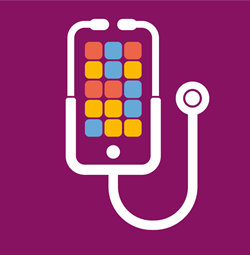 And a study by consultancy Mercer published in February 2020 found that over half of workers globally were willing to try telemedicine for a simple health issue like a rash or a cold but also for a significant health issue like diabetes. Around 68% of employers globally said they expect to increase their investment in this area, 40% of employees said they would be more likely to stay with a company that offers digital solutions.3
And a study by consultancy Mercer published in February 2020 found that over half of workers globally were willing to try telemedicine for a simple health issue like a rash or a cold but also for a significant health issue like diabetes. Around 68% of employers globally said they expect to increase their investment in this area, 40% of employees said they would be more likely to stay with a company that offers digital solutions.3
68% of employers globally said they expect to increase their investment in telemedicine, and more significantly perhaps, 40% of employees say they would be more likely to stay with a company that offers digital solutions.
Remote healthcare – a core service now and in the future
Smartphone-based services, platforms and apps that already allow people to monitor their own health – such as their blood pressure – or speak remotely with medical professionals offer tantalising insights into the future of healthcare
2020 will, no doubt, be seen as the year that telemedicine and remote healthcare became a truly practical, effective and often vital means of delivering an-ever expanding range of health services.
With physical healthcare infrastructures so disrupted by COVID-19, ‘virtual’ doctors, telemedicine and EAP services have exploded in popularity as a way to meet urgent healthcare needs and deliver longer-term, ongoing consultations and practical help. Even in a post-COVID-19 world, it’s likely these will be a core part of an employee’s healthcare package – the world has changed and with it, the way we expect to access services.
One US study, published in December last year, found that just 9% of eligible employees in 2019 were using telemedicine services compared to 14% within the first six months of 2020.4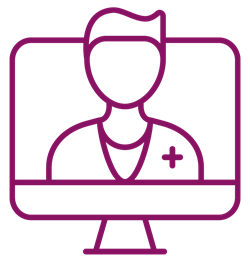
It also found that employers were pleased with the performance of their telemedicine providers: 74% were very satisfied or satisfied, only 2% were dissatisfied, and 80% said it will play a larger role in their healthcare benefits package going forward.
Employers were largely pleased with the performance of their telemedicine providers: 74% were very satisfied or satisfied and only 2% were dissatisfied…
Health on demand – a global perspective3
Consultant Mercer published a major study in February last year called Health on Demand. While it was published before the pandemic, the report was one of the most comprehensive studies into the market. It featured insights from over 16,500 workers and 1,300 senior decision makers across 13 markets (seven developed economies and six fast-growth ones).
The study had six key findings and six considerations. The key findings included that there’s a strong business case for digital health, workers value patient-centred solutions and there are low barriers to adoption.
The six considerations were:
- Digital health and wellbeing solutions will be of increasing importance in retaining, engaging and energising workers.
- For workers, digital health solutions have a clear role in facilitating personalised healthcare.
- Workers are surprisingly willing to share health data to receive higher quality, more personalised and convenient care.
- Unique worker segments have different attitudes towards health innovation and require tailored targeting.
- Workers value a pro-health work culture – which has important implications for digital health solutions.
- More workers in growth markets are ready for digital health now but across all markets, workers are open to digital solutions that address their needs.
The report stated:
Employers believe these investment plans have a clear justification. [We] asked senior decision makers to rank their objectives for their organisations health and wellbeing programmes and the top four all have direct impact on business results.”
What’s next? Apps, artificial intelligence and virtual reality
It’s not just the use of telemedicine that is growing fast – a huge range of additional services, most often delivered through apps, are also gaining ground as effective ways to track wellness, treat ailments and chronic conditions – like diabetes, musculoskeletal problems etc – as well as serious mental health conditions.
Looking forward, emerging technologies, such as augmented and virtual reality-led services, could represent exciting new opportunities in the delivery of remote healthcare, while the role that artificial intelligence plays could escalate. A recent study projected that the global virtual reality healthcare market will reach US$34 billion in value by 2027, growing at around 40% per year.5
The smartphone – a medical device in your pocket?
Smart watches have become extremely popular commercially – and are even sometimes included as part of an employee’s wellness package – to monitor and analyse heart rates, VO2max rates etc and to encourage you to keep moving. They’re just one example of a growing area in the health-tech sector – sophisticated, highly technical products and services that connect directly to smartphones and turn them into semi-medical devices.
And of course, you’ve all heard of smart watches, but here are some example of mobile health tech you may not have heard of…
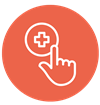 Tracking your BP with LMD
Tracking your BP with LMD
Leman Micro Devices (LMD) has created a device that sits on the back of a phone that can track your blood pressure (BP) just by pushing your finger down on it. It uses the arteries on the tip of the finger to take a reading of your BP.6
A selfie that monitors your vital signs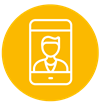
How can a selfie help monitor your vitals? Binah.ai uses a smartphone, tablet or laptop camera to monitor vital signs in under a minute, just by looking at your face. It analyses the colour changes in your cheeks and forehead to understand your blood flow – the app can use this data to determine your heart rate, oxygen saturation, respiration rate, stress levels and more.7
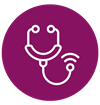 The smartphone stethoscope
The smartphone stethoscope
StethIO has designed and developed a stethoscope that attaches to a smartphone and analyses the sound of the heart in real-time. The device uses a sound capture module to record sounds and construct a spectrogram to show a patient’s heart rhythm.8
Taking readings with Tyto
 Just like StethIO, TytoCare has developed a comprehensive doctors examination kit that can be used in your own home. A series of attachments allow users to perform checkups using an exam camera, an otoscope (for examining ears), a stethoscope (for heart and lung sounds), a tongue depressor (for throat exams) – all of which connect to the TytoApp which can be used to speak directly to a doctor or be stored and sent to your own physician.9
Just like StethIO, TytoCare has developed a comprehensive doctors examination kit that can be used in your own home. A series of attachments allow users to perform checkups using an exam camera, an otoscope (for examining ears), a stethoscope (for heart and lung sounds), a tongue depressor (for throat exams) – all of which connect to the TytoApp which can be used to speak directly to a doctor or be stored and sent to your own physician.9
Portable ultrasound anywhere
 Another interesting device that has come to market is from Butterfly iQ, a US-based healthtech company that has designed a portable ultrasound device that delivers a 2D array of 9,000 micro-machined sensors connected to a smartphone. The device has a built-in battery and wireless charging and can scan for over two hours.8
Another interesting device that has come to market is from Butterfly iQ, a US-based healthtech company that has designed a portable ultrasound device that delivers a 2D array of 9,000 micro-machined sensors connected to a smartphone. The device has a built-in battery and wireless charging and can scan for over two hours.8
As phones become smarter and technologies more sophisticated, it’s likely that employees as well as medical practitioners will be able to use their phones not only to monitor general health but also to detect, diagnose and manage conditions on an ongoing basis.
What should employers be doing in this space?
While multinational employers have themselves become smart in the use of technology to better serve their employees and deliver effective employee benefits programmes, in the area of health and wellness they are likely to be kept on their toes by the rapid pace of change.
Telemedicine and the many app-based programmes have increased in both importance and popularity and, looking ahead, employers should be offering this type of cost-effective and convenient care for their people. Studies have found that employees are increasingly comfortable and happy to use these services and, given the experiences of the last year, are far more likely to see the benefits.
However, given the rapid growth of the digital health sector and an explosion in the types of services available – Apple itself says its App Store now features over 40,000 healthcare apps alone10 – one of the key challenges for employers is how to select the services that are right for them and their employees. Of course, they need to consider cost, compliance, local market regulations, and much more.
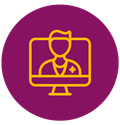 Technology is growing and evolving at such an incredible pace, things that would have been considered science fiction a couple of decades ago are now a reality. Smartphone-based services, platforms and apps that already allow people to monitor their own health – such as their blood pressure – or being treated remotely by medical professionals are clear indicators of a trend. The healthcare market was already undergoing a revolution and the pandemic is only speeding things up.
Technology is growing and evolving at such an incredible pace, things that would have been considered science fiction a couple of decades ago are now a reality. Smartphone-based services, platforms and apps that already allow people to monitor their own health – such as their blood pressure – or being treated remotely by medical professionals are clear indicators of a trend. The healthcare market was already undergoing a revolution and the pandemic is only speeding things up.
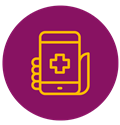 Lack of access to traditional healthcare has meant the focus is on multinationals – and their partners such as insurance companies and benefits networks – to offer effective, up-to-date digital solutions for employees to ensure they’re happy and healthy. The good news is that the most proactive employers are already reflecting this exciting shift towards more tech-enabled services and solutions in their employee benefits packages and are potentially saving money.
Lack of access to traditional healthcare has meant the focus is on multinationals – and their partners such as insurance companies and benefits networks – to offer effective, up-to-date digital solutions for employees to ensure they’re happy and healthy. The good news is that the most proactive employers are already reflecting this exciting shift towards more tech-enabled services and solutions in their employee benefits packages and are potentially saving money.
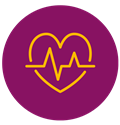 And because the world has changed, so have your employees’ expectations for medical benefits – they want access to these digital solutions for everyday care from the convenience of their own home. Even when the pandemic is over, it’s hard to imagine we’ll go back to the ‘old way’ of only in-person medical treatment. Digital solutions are a new reality and employers need to be ready – are you prepared to help your employees turn their phones into medical devices?
And because the world has changed, so have your employees’ expectations for medical benefits – they want access to these digital solutions for everyday care from the convenience of their own home. Even when the pandemic is over, it’s hard to imagine we’ll go back to the ‘old way’ of only in-person medical treatment. Digital solutions are a new reality and employers need to be ready – are you prepared to help your employees turn their phones into medical devices?
1 Daniel Cohen, Amy Hung, Eli Weinberg, and Dandi Zhu, McKinsey and Company, https://www.mckinsey.com/industries/pharmaceuticals-and-medical-products/our-insights/healthtech-in-the-fast-lane-what-is-fueling-investor-excitement (sourced Jan 2021)
2 Anon, Zion Market Research https://www.globenewswire.com/news-release/2019/01/24/1704860/0/en/Global-mHealth-Apps-Market-Will-Reach-USD-111-1-Billion-By-2025-Zion-Market-Research.html (sourced Jan 2021)
3 Anon, Mercer https://www.mercer.com/content/dam/mercer/attachments/private/gl-2020-health-on-demand-global-report-28-jan-mercer.pdf (sourced Jan 2021)
4 Anon, Mercer https://www.mercer.com/newsroom/with-slow-health-benefit-cost-growth-in-2020-employers-plan-to-invest-in-more-support-for-employees-says-mercer.html (sourced Jan 2021)
5 Anon, Verified Rarket Research https://www.verifiedmarketresearch.com/product/virtual-reality-in-healthcare-market/ (sourced Jan 2021)
6 https://www.eetimes.com/health-monitoring-system-integrated-in-a-smartphone/#
7 Anon, Binah.ai https://www.binah.ai/ (sourced Feb 2021)
8 Lorenzo Gutierrez, Starfish Medical https://starfishmedical.com/blog/smartphones-as-a-medical-device/ (sourced Jan 2021)
9 Anon, TytoCare https://www.tytocare.com/ (sourced Feb 2021)
10 Anon, Apple https://www.apple.com/uk/healthcare/products-platform (sourced Jan 2021)
This document has been prepared by MAXIS GBN and is for informational purposes only – it does not constitute advice. MAXIS GBN has made every effort to ensure that the information contained in this document has been obtained from reliable sources, but cannot guarantee accuracy or completeness. The information contained in this document may be subject to change at any time without notice. Any reliance you place on this information is therefore strictly at your own risk. This document is strictly private and confidential, and should not be copied, distributed or reproduced in whole or in part, or passed to any third party.
The MAXIS Global Benefits Network (“Network”) is a network of locally licensed MAXIS member insurance companies (“Members”) founded by AXA France Vie, Paris, France (AXA) and Metropolitan Life Insurance Company, New York, NY (MLIC). MAXIS GBN, a Private Limited Company with a share capital of €4,650,000, registered with ORIAS under number 16000513, and with its registered office at 313, Terrasses de l’Arche - 92 727 Nanterre Cedex, France, is an insurance and reinsurance intermediary that promotes the Network. MAXIS GBN is jointly owned by affiliates of AXA and MLIC and does not issue policies or provide insurance; such activities are carried out by the Members. MAXIS GBN operates in the UK through its UK establishment with its registered address at 1st Floor, The Monument Building, 11 Monument Street, London EC3R 8AF, Establishment Number BR018216 and in other European countries on a services basis. MAXIS GBN operates in the U.S. through MetLife Insurance Brokerage, Inc., with its address at 200 Park Avenue, NY, NY, 10166, a NY licensed insurance broker. MLIC is the only Member licensed to transact insurance business in NY. The other Members are not licensed or authorised to do business in NY and the policies and contracts they issue have not been approved by the NY Superintendent of Financial Services, are not protected by the NY state guaranty fund, and are not subject to all of the laws of NY. MAR00778/0221